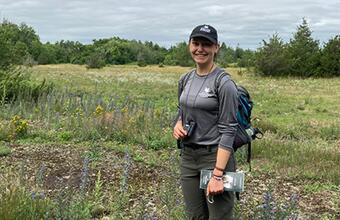
Originally from King City, Ontario, Mary Anne Schoenhardt is new to Queen’s Department of Environmental Studies (DES). Mary Anne brings with her a unique undergraduate experience from McMaster University, where she studied Integrated Sciences. This program emphasizes collaborative project-based learning, while also providing room for independent research projects and an undergraduate thesis. Mary Anne’s thesis combined her interest in conservation biology and her minor in geographic information systems (GIS) to study how to increase growth of eastern flowering dogwood, an endangered species.
After considering a career in teaching, Mary Anne realized that her passions for conservation biology and science communication can be fulfilled outside of the classroom. “I always laugh when I say this,” Mary Anne explained, “but I decided to get a masters, which is school in a different way.” From her undergraduate projects, Mary Anne knew that she wanted to further hone her skills in GIS and conduct her own field research. She also wanted to participate in science communication, which she had studied in undergraduate courses.
Mary Anne’s background makes her a perfect fit for Environmental Studies at Queen’s. Climate change is a multifaceted problem, meaning it is likely to be solved with an interdisciplinary approach. DES at Queen’s provides interdisciplinary sustainability training in areas such as Environmental Chemistry and Toxicology, Ecosystem and Human Health, and Environment and Safety. Many researchers are cross appointed in chemistry, geography and planning, biomedical and molecular sciences, philosophy, and global development studies.
Dr. Ryan Danby’s lab was a perfect fit for Mary Anne. She was drawn to many of the lab’s research projects, which focus on ecosystem changes and biodiversity conservation. Mary Anne told me that she chose the Danby lab because she was interested in both the methods they are using and the questions they are answering. Mary Anne will be researching the relationship between changing vegetation and habitat use of Dall sheep in the Yukon.
It's easy to miss why Dall sheep matter – I hadn’t even heard of them before my conversation with Mary Anne. However, she effortlessly explained their importance during our conversation. Dall sheep “have cultural significance for first nations groups and are economically important in that they draw a lot of tourists for wildlife viewing in Kluane National Park.” They’re also a good case study in how climate change is impacting species in the circumpolar north, a region experiencing rapid environmental shifts. As Canada’s north warms, southern vegetation can move further north and upslope, threatening the alpine habitat of many species. Kluane National Park has collected data on Dall sheep for 45 years, making their changing herd size and location a good predictor for how climate change may be impacting other species.
Mary Anne is looking forward to program-funded field work in the Yukon this summer. “I think it’s really valuable to see where you’re working. It’s an important skill in conservation biology to not just know something, but to actually see it and do it yourself.” Mary Anne works to foster this passion for hands-on learning through her volunteer work with the Kingston Junior Naturalist Club, facilitating monthly field trips with children under 12. “It’s something I really enjoy in that it forces me to really think about things. Kids ask really great questions!”
It seems like one of the best words to describe Mary Anne is ‘curious.’ She loves exploring diverse scientific topics, both in her academic career and through her volunteer work with the STEM blog Science Borealis. Mary Anne is looking forward to further exploring a variety of research topics through her work as a SGS Spotlight Writer and her graduate work here at Queen’s. These opportunities, and her work with the naturalist club, support Mary Anne’s goal of developing her already impressive science communication skills. If we’re going to solve the multifaceted problem of climate change, we need more science communicators like Mary Anne.
Caption for photo:
“I really enjoy being outside and in the world around me, but how can I communicate this to the people around me? People typically don’t have a reason to care about something they don’t understand, so I’m looking at how I can incorporate ways to do science myself while communicating the importance of it to others and getting people to care.”
To learn more about graduate programs with the Queen’s Department of Environmental Studies go to their website.
